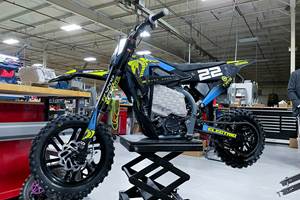DMRC Research Examines Properties of SLM Components
What will it take to bring metal 3D printing up to the level of true production manufacturing?
The effective use of AM in manufacturing demands repeatability, full use of AM properties and the production of functional parts that meet specifications. The Direct Manufacturing Research Center (DMRC) of the University of Paderborn, Germany, was founded five years ago as a joint effort between academia and industry to advance existing additive technologies into dependable production manufacturing technologies. Fused deposition modeling (FDM), selected laser sintering (SLS) and selective laser melting (SLM) are being examined, analyzed and compared by DMRC to better understand how each can be optimized in applications.
Recent projects at the DMRC have focused on product optimization with SLM. Researchers are looking at material qualification, which consists of regular checks of particle dispersions and particle micrographics; product qualification that will consider quasi static and fatigue behavior under high temperature atmosphere; process qualification that includes the analysis of optimal process parameters and heat treatment; and quality management by testing the part’s powder, mechanical and geometrical qualities.
“One project focused on the comparison between the SLM 250HL and the SLM 280HL from SLM Solutions with respect to the build-up rate and the resulting component quality,” explains Dr. Eric Klemp, director of the DMRC. “The main objective was to compare two fundamentally different SLM systems in terms of cycle time and component properties.”
“Test samples were manufactured on each of these two machines to measure the process cycle time of both systems, using three layer thicknesses: 50 microns, 100 microns and 150 microns,” says Klemp. According to the project report, in order to obtain detailed values for exposure and recoating times, a real-time data collection script was developed that scanned the SLM-log files of the time data required for recoating and exposure in each layer.
Part properties were evaluated closely to measure any improvements. This process included characterization and comparison of the mechanical properties of the SLM materials with regard to process cycle time improvements. Testing revealed the possibility to increase the build-up rate by about 39 percent using the SLM 280HL compared to the previous generation SLM 250HL system. In experiments using stainless steel 316L, “The SLM system 280HL assured a significant increase in the build-up rate of the material,” says Klemp.
Klemp explained that the tests included the influence of production parameters of the new exposure strategy on the mechanical properties, measuring the variation of the energy density as well as exposure parameters and quantification of the impact on the component properties. Optimization of the lattice structures manufactured by the SLM method involved examining the microstructure characterization and the influence of processing and heat treatment on the resulting microstructure. Then, mechanical testing was performed to determine the structure performance under diverse loading conditions in the monotonic and cyclic loading regime.
“Structurally, they were found to be comparable to machined metal parts, and able to contribute to the development of lightweight structures if you design the lattice grid to different strengths,” says Klemp.
The two DMRC departments responsible for the research project, Automotive Lightweight Construction and Institute of Applied Mechanics, transferred the results regarding optimal balance between build-up rate and component quality to an actual component in order to demonstrate the performance of this AM technology. This data will be used in development of the next generation SLM systems, taking production to the next level for end-use components.
Related Content
10 Important Developments in Additive Manufacturing Seen at Formnext 2022 (Includes Video)
The leading trade show dedicated to the advance of industrial 3D printing returned to the scale and energy not seen since before the pandemic. More ceramics, fewer supports structures and finding opportunities in wavelengths — these are just some of the AM advances notable at the show this year.
Read MoreNew Electric Dirt Bike Is Designed for Molding, but Produced Through 3D Printing (Includes Video)
Cobra Moto’s new all-electric youth motocross bike could not wait for mold tooling. Parts have been designed so they can be molded eventually, but to get the bike to market, the production method now is additive manufacturing.
Read MoreMultimaterial 3D Printing Enables Solid State Batteries
By combining different 3D printing processes and materials in a single layer, Sakuu’s Kavian platform can produce batteries for electric vehicles and other applications with twice the energy density and greater safety than traditional lithium-ion solutions.
Read More3D Printing with Plastic Pellets – What You Need to Know
A few 3D printers today are capable of working directly with resin pellets for feedstock. That brings extreme flexibility in material options, but also requires greater knowledge of how to best process any given resin. Here’s how FGF machine maker JuggerBot 3D addresses both the printing technology and the process know-how.
Read MoreRead Next
Hybrid Additive Manufacturing Machine Tools Continue to Make Gains (Includes Video)
The hybrid machine tool is an idea that continues to advance. Two important developments of recent years expand the possibilities for this platform.
Read More4 Ways the Education and Training Challenge Is Different for Additive Manufacturing
The advance of additive manufacturing means we need more professionals educated in AM technology.
Read More3D Printing Brings Sustainability, Accessibility to Glass Manufacturing
Australian startup Maple Glass Printing has developed a process for extruding glass into artwork, lab implements and architectural elements. Along the way, the company has also found more efficient ways of recycling this material.
Read More




















